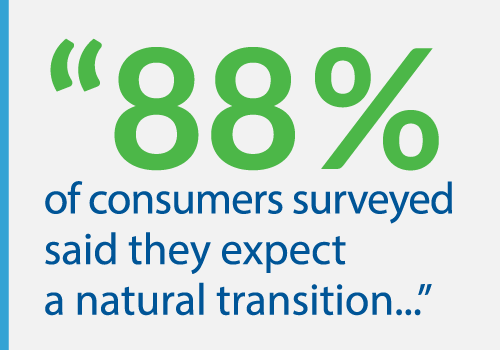
Trends that get business traction
Is the business year ending the way you thought it would?
For instance, are your call centers well in hand, satisfying digital consumers? Or, are they lagging behind, out of touch?
Sure, you read about the latest customer service trends. But did you factor them into your operations?
To get traction, trends need to be integrated into business. Optimized to deliver great service and satisfaction.
Before this year ends, let’s review a few trends that got traction—and will gain more ground in 2018.
Trend #1: Service Solutions Need AI and IAs
Automated self-service solves simple, online transactions. Consumers welcome the convenience. With artificial intelligence, AI-enabled voice assistants are cozying up to consumers. But, they’re not quite human yet.
 In a recent VentureBeat article on AI, service-desk executive Steve Stover, writes: “An overwhelming 88 percent of consumers surveyed said they expect a natural transition between automated self-service technologies, like voice-based virtual assistants, and a human agent when purchasing a product, placing an order, or contacting customer service.”
In a recent VentureBeat article on AI, service-desk executive Steve Stover, writes: “An overwhelming 88 percent of consumers surveyed said they expect a natural transition between automated self-service technologies, like voice-based virtual assistants, and a human agent when purchasing a product, placing an order, or contacting customer service.”
To complement AI, intelligent agents—or IAs—are still key to great customer service. Here’s why.
The complexity of certain transactions requires highly trained agents with more sophisticated skills and deeper expertise. Consider booking global travel, deciphering all those far-flung reservations systems. Or unraveling healthcare billing from multiple providers—in network and out.
AI might not be programmed for the workarounds or common-sense solutions a long-time agent knows. Also, for human-enabled service, agent personalities can better fit the customer personas they’re serving.
That’s what the Harvard Business Review (HBR) concluded in a survey of 1,400 service reps. HBR looked at where IT leaves off and agents step in. We concur. To serve customers well in 2018, a business needs the right blend of artificial intelligence and intelligent agents.
Trend #2: Consumers Are Redefining Their Experiences
Been to the mall lately? If not, why not? In a word, Amazon, which caters to consumers at their doorsteps.

Traditional retailers—such as Payless Shoes and J.C. Penney—are shutting stores left and right. No secret there. But here’s the kicker. Forbes reported there would be more retail closings than openings in 2017, and the trend is likely to continue in 2018.
Still, consumers desire experiences, in-store and online, but redefined. For instance, pop-up shops are opening for a few days for product launches or event-driven sales. Millennials like them. So expect more next year.
According to Toronto Metro: “The practice allows the company to develop an experience for consumers they don’t get to interact with in stores, and re-invent a brand for new, younger demographics.”
After pop-ups close, consumers can continue their experiences online. But only if the virtual customer service—delivered by AI, IAs or both—promotes ongoing engagement and satisfaction. Especially now, as customers shop at will.
In 2018, will businesses—pop-up shops or not—be ready for them in the long term? And be open for more than just a few days?
Trend #3: Fluid Businesses Need “Liquid” Workforces
These shops epitomize fluid business. And they require customer service operations with the same flexibility.
Management consultant Accenture characterizes it as the “liquid” workforce, which ebbs and flows. It’s a core of salaried professionals, backed by an outside network of for-hire experts.
Videogaming exemplifies the trend. As The Wall Street Journal reports: “The videogame industry’s contractor-heavy model resembles Hollywood studios, which hire temporary workers ranging from directors to actors to publicists to make a film and have few long-term obligations after its release.”
This on-demand model is nothing new for distributed contact center outsourcing. Independent contractors, or agents, scale up or down with market fluctuations, sales cycles and seasonal sales. Located across the country, they embody the mobile workforces that fluid businesses need today.
Now, compare this to brick-and-mortar call centers, which continue to defy modern thinking. They’re bound by ZIP codes, which limits talent. Restricted by square footage, cramping flexibility.
Sadly, any business using this antiqued model is locked in, too. Its customer service stuck in place. And that’s no place to be in 2018.
-
Related Posts
-

10 Women in Customer Experience (CX) to Follow…
03/28/2024 Gail Rigler -

The Trust Factor: Why Live Agents Still Matter…
10/06/2023 Gail Rigler -

In-House vs. Outsourced Customer Service Cost Comparison
08/22/2023 Gail Rigler
-
-
Recent Posts
-

Embrace the Future: Elevating Customer Service with Smart…
04/25/2024 Ashok Narayanan -

10 Women in Customer Experience (CX) to Follow…
03/28/2024 Gail Rigler -

Future-Proofing Customer Service: The Power of Smart Technology…
04/01/2024 Ashok Narayanan
-
-
Ws News
-

Working Solutions Commands #1 Spot in FlexJobs Top…
01/10/2024 Springfield Lewis -

Kim Houlne Shares Her Insights on “Something Extra”…
08/04/2023 Springfield Lewis -

Working Solutions Honored for Exceptional Customer Service in…
04/12/2023 Springfield Lewis
-